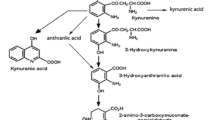Summary
The pharmacokinetics of oralL-threo-3,4-dihydroxyphenylserine (L-threo-DOPS) was studied in 7 normal subjects and 7 patients with familial amyloid polyneuropathy. Each person swallowed a single 300 mg dose in the fasting state, andL-threo-DOPS in plasma and urine was determined by high performance liquid chromatography with an electrochemical detector after separation on a boric acid gel column.L-threo-DOPS was slowly absorbed by normal subjects; the maximum plasma concentration occurred 3 h after administration and 20% of the oral dose was recovered unchanged in the urine within 12 h. It induced a substantial elevation of plasma norepinephrine levels, the peak being attained at 5 h, but without any change in blood pressure. In the patients, the absorption and metabolism ofL-threo-DOPS were delayed, and a prolonged pressor response was observed, with a peak after 8 h. It was concluded that the effects on plasma norepinephrine and blood pressure of oralL-threo-DOPS were essentially equal to those of twice as large a dose ofDl-threo-DOPS.
Similar content being viewed by others
References
Araki S, Mawatari S, Inokuchi T (1970) Amino acids of serum and urine in familial amyloidotic polyneuropathy. Arch Neurol 23: 9–13
Araki H, Tanaka C, Fujiwara H, Nakamura M, Ohmura I (1981) Pressor effect of L-threo-3,4-dihydroxyphenylserine in rats. J Pharm Pharmacol 33: 772–777
Cochran WG (1964) Approximate significance levels of the Behrens-Fisher test. Biometrics 20: 191–195
Dengler H, Reichel G (1957) The influence of a decarboxylase inhibitor on the action of DOPA and DOPS on blood pressure. Arch Exp Pathol Pharmacol 232: 324–326
Gunne LM, Lidvall HF (1966) The urinary output of catecholamines in narcolepsy under resting conditions and following administration of dopamine, dopa, and dops. Scand J Clin Lab Invest 18: 425–430
Higa S, Suzuki T, Sakoda S, Hayashi A, Yamamura Y, Yoshida J, Yoshino K, Matsunaga T (1980) A new method for determination of free normetanephrine and metanephrine in urine by selected ion monitoring. Proc Jpn Soc Med Mass Spectrom 5: 165–168 (in Japanese with English abstract)
Hokin LE, Hokin MR (1963) Biological transport. Annu Rev Biochem 32: 553–578
Imai K, Sugiura M, Tamura Z, Hirayama K, Narabayashi H (1971) The plasma levels of DOPA and catecholamines after oral administration ofL-DOPA. Chem Pharm Bull 19: 439–440
Inagaki C, Fujiwara H, Tanaka C (1976) Inhibitory effect of (+)threo-3,4-dihydroxyphenylserine (DOPS) on decarboxylation of (−)threo-DOPS. Jpn J Pharmacol 26: 380–382
Inagaki C, Tanaka C (1978) Characteristics of enzymic decarboxylation ofL-threo-3,4-dihydroxyphenylserine using hog renalL-aromatic amino acid decarboxylase. Biochem Pharmacol 27: 1081–1086
Nagatsu T, Udenfriend S (1972) Photometric assay of dopamine-β-hydroxylase activity in human blood. Clin Chem 18: 980–983
Patil PN, Miller DD, Trendelenburg U (1975) Molecular geometry and adrenergic drug activity. Pharmacol Rev 26: 323–392
Pletcher A, Bartholini G, Gey KF, Jenni A (1970) The biochemical basis for treatment of Parkinsonian syndrome with L-DOPA. Schweiz Med Wochenschr 100: 797–804
Redmond DE Jr, Olander R, Maas J (1975) Cardiovascular effects of D,L-threo-dihydroxyphenylserine in cats. Toxicol Appl Pharmacol 34: 301–308
Suzuki T, Tsuge I, Higa S, Hayashi A, Yamamura Y, Takaba Y, Nakajima A (1979) Catecholamine metabolism in familial amyloid polyneuropathy. Clin Genet 16: 117–124
Suzuki T, Higa S, Tsuge I, Sakoda S, Hayashi A, Yamamura Y, Takaba Y, Nakajima A (1980) Effect of infused L-threo-3,4-dihydroxyphenylserine in patients with familial amyloid polyneuropathy. Eur J Clin Pharmacol 17: 429–435
Suzuki T, Higa S, Sakoda S, Hayashi A, Yamamura Y, Takaba Y, Nakajima A (1981) Orthostatic hypotension in familial amyloid polyneuropathy: treatment withDl-threo-3,4-dihydroxyphenylserine. Neurol (Ny) 31: 1323–1326
Yoshida J, Yoshino K, Matsunaga T, Higa S, Suzuki T, Hayashi A, Yamamura Y (1980) An improved method for determination of plasma norepinephrine: Isolation by boric acid gel and assay by selected ion monitoring. Biomed Mass Spectrom 7: 396–398
Author information
Authors and Affiliations
Rights and permissions
About this article
Cite this article
Suzuki, T., Higa, S., Sakoda, S. et al. Pharmacokinetic studies of oral L-threo-3,4-dihydroxyphenylserine in normal subjects and patients with familial amyloid polyneuropathy. Eur J Clin Pharmacol 23, 463–468 (1982). https://doi.org/10.1007/BF00605999
Received:
Revised:
Accepted:
Issue Date:
DOI: https://doi.org/10.1007/BF00605999




